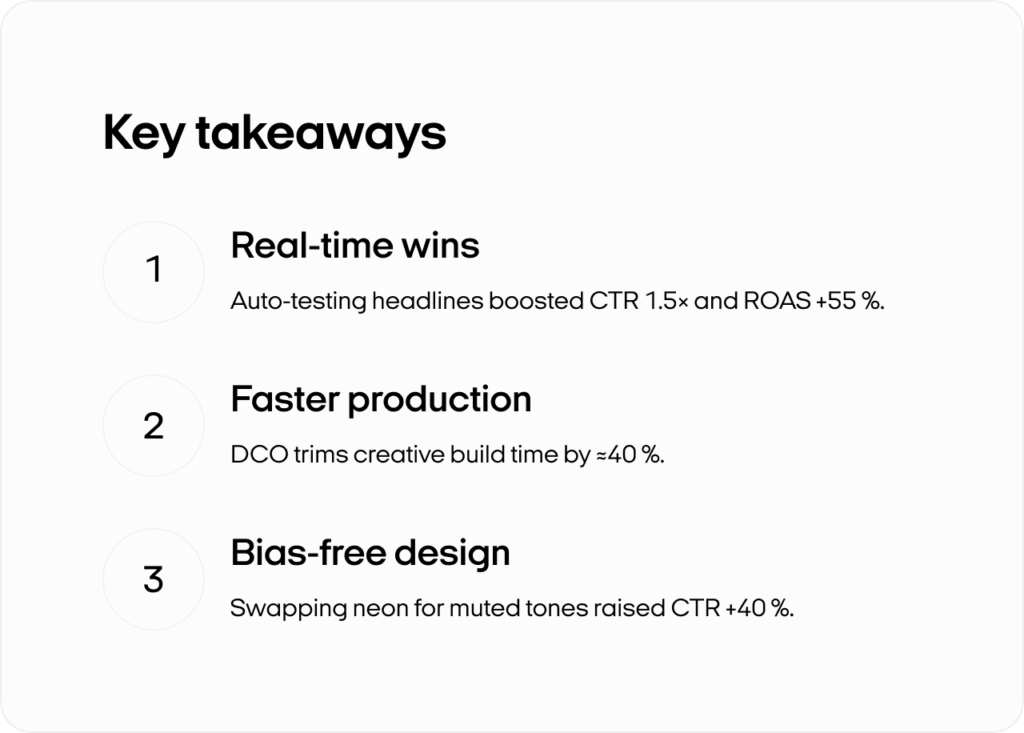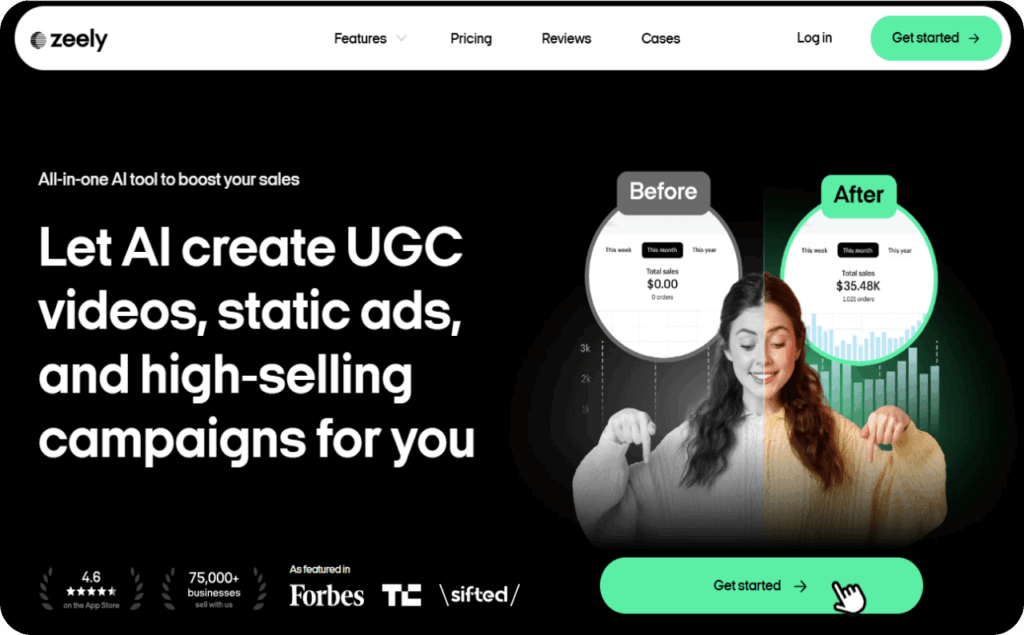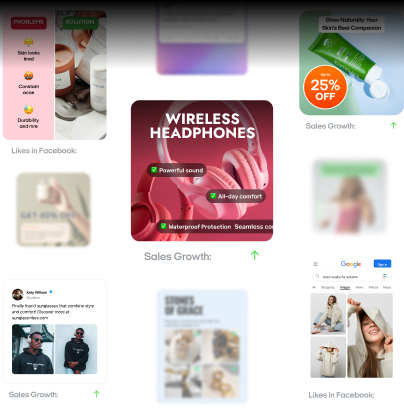Dynamic creative optimization: 5 reasons to use it in your ads
What if your ads could automatically tailor themselves to every viewer? Discover five reasons dynamic creative optimization is transforming ad performance.
Dynamic creative optimization delivers hyper-personalized ads in real time. Instead of pushing generic banners, it uses machine learning and programmatic technology to tailor images, headlines, and calls-to-action for each viewer.
It taps into data from creative management platforms, data management platforms, or your CRM. That means it can spot whether someone is browsing from a snowy region or has abandoned an online shopping cart, then serve the perfect creative variation.
As marketing budgets grow, the competition intensifies. Ad spending jumped by eight percent in 2024, nearing 792 billion U.S. dollars. That surge makes every impression more competitive — and more expensive. You need a smarter strategy to stand out.
DCO tracks performance metrics as soon as an ad appears. The system learns which elements, like visuals or copy, drive the most clicks and conversions. It then updates subsequent impressions automatically.
Real-time analytics show you what’s working, so you don’t have to guess. Predictive modeling refines your targeting further. This approach boosts ROAS and frees you from constant manual testing.

Definition of dynamic creative optimization
If you’ve ever struggled with ad testing, wondering which headline or image works best, dynamic creative optimization can eliminate the guesswork. It’s a data-driven personalization method that instantly adapts your ad’s visuals and messaging based on user context.
Instead of a single, static banner, AI in advertising and machine learning power real-time changes to headlines, images, or offers. DCO taps into data management platforms, creative management platforms, and DSPs to track user signals and deliver the most relevant creative.
How it works
- Your DMP segments users by attributes such as past purchases, demographics, or on-site behavior
- DCO pulls those segments, pairs them with creative elements in your CMP, and automatically assembles ad variations
- Through a DSP, the ad is served to the right audience in milliseconds
- Real-time analytics track performance. If one variation outperforms another, the system pivots immediately
Performance gains
Brands using DCO often see a 30–50% boost in click-through rates and up to 2x improvement in ROAS compared to static ads. For example, Amazon emphasizes that DCO is used to replace product images and localized offers, reducing manual updates, increasing scale and efficiency. You control the building blocks — DCO just automates the fine-tuning.
Why it matters
Static ads can’t flex when user preferences shift. DCO ensures every impression feels personal and timely, solving key pain points like wasted spend on irrelevant ads. In the next section, we’ll show you how DCO compares to static creatives and why dynamic strategies lead to higher engagement and stronger results.
How DCO differs from static creative
If your ads never adapt to user preferences, you’re missing big opportunities. Static creatives can’t keep up with changing trends or unique data points.
That’s where DCO comes in, shifting headlines, images, and offers in real time so each impression feels personal. Below, we’ll see why dynamic ads beat static ones and how they turn a generic flyer into a custom note that speaks directly to each user.
Why are dynamic ads more effective?
Static ads act like fixed flyers: they never change, no matter who sees them. Dynamic ad creatives, fueled by real-time optimization, work more like personalized notes. They tailor everything, from headlines to images, based on each user’s data profile. If a user looked at running shoes yesterday, DCO can highlight a discount on those exact shoes today.
Balancing automation and control
Although DCO is highly automated, you still define the creative assets and rules. The technology just decides which combination to serve each user, then refines it on the fly. You save time otherwise spent on guesswork.
Ready to dive deeper? Next, we’ll outline the exact steps to set up a DCO campaign, so you can put these principles into action.
How does dynamic creative optimization work?
Data can feel overwhelming — cart abandons, location data, and even weather patterns. DCO pulls those signals together and delivers personalized ads in near real time. You’ll see how it integrates different data sources, applies AI for instant decisions, and uses a CMP to scale creative output. Short sentences, simple steps.
Data inputs and integration
DCO relies on first-party data and third-party data. When someone abandons a cart on your site, your CRM logs the event. A tool like Segment or Tealium then shares that info with your DMP. The DMP updates your DSP, which decides who sees your ad. Meanwhile, your CMP supplies images and headlines in milliseconds.
Privacy and consent matter. Platforms often include consent management features so you only share data if users say yes. Watch out for syncing delays or siloed systems. An iPaaS or strong API connections keep everything talking to each other. If the user’s data isn’t ready fast enough, you can use a fallback ad.
AI, machine learning, and automation
Manual ad testing is slow. AI-powered advertising flips the script by analyzing performance on the spot. If your system sees that “Free Shipping” resonates with night owls, it uses predictive modeling to adjust every late-night ad. You don’t wait for tomorrow’s report. The model updates headlines and images in real time.
When the DSP sees fresh click or conversion data, your machine learning engine compares it to past trends. That engine predicts which creative should appear next. If performance dips, it pivots without you lifting a finger. AI is smart, but it can’t fix bad design. Keep an eye on your visuals to make sure they stand out.
The role of CMPs
While DCO picks which ad variant to show, your CMP stores and organizes those creative elements. A single master template can spin out many design variations. That’s how you scale creative output fast. Change a headline once, and it updates across all your ads.
A CMP also keeps your branding consistent. If you notice an off-brand image, you fix it in the CMP, and it disappears from every dynamic ad. Bannerflow is one platform that links seamlessly with DCO tools. You upload assets, define a theme, and let DCO do the rest. Next, we’ll see how to measure real ROI from these dynamic ads so you can refine your campaigns even more.
Benefits of dynamic creative optimization
When your ads adapt to each viewer’s unique context, you don’t just boost clicks — you elevate the entire campaign experience. DCO personalizes content in real time, fitting seamlessly into your existing tech stack.
Below, you’ll see how DCO raises engagement, scales your production, and removes creative bias. You’ll also learn how to measure results and pivot your campaigns with ease.
Increased engagement and conversions
DCO taps into your CRM and DMP, often through an API or a platform like Segment, to collect browsing data, past purchases, and demographic details.
It then runs multivariate tests on headlines, images, and calls-to-action in real time. One retailer reported a 1.5x jump in CTR and a 55% lift in ROAS after switching to a “Winter Clearance” headline that beat out a generic alternative.
You still control creative inputs through a creative management platform. DCO simply decides which element goes to which audience based on real-time performance metrics. By continuously measuring CTR, ROAS, and conversions, you zero in on what resonates and quickly phase out what doesn’t.
If you see a weak spot, DCO’s data-driven insights guide swift changes. Instead of guesswork, you rely on objective numbers. The result is performance-focused advertising that makes every impression count.
Operational efficiency and scalability
Manual tweaks for different audiences can waste hours. DCO automates those edits behind the scenes. You load your creative assets into a CMP, segment audiences in a CRM or DMP, and let DCO do the rest. If your analytics reveal that a specific CTA performs better with night owls, DCO updates the late-night ads automatically.
Many marketers report a 40% reduction in creative production time with DCO. You don’t build each variation from scratch. You set your rules, and the system matches each user to the right headline, color scheme, or image. That means more time to refine strategy, instead of juggling endless ad sets.
When you spot a particular design failing, DCO replaces it with a better option — no frantic edits needed. This real-time optimization keeps your campaigns agile, letting you respond to market shifts in minutes.
Reducing bias with data-driven creativity
According to Forbes, it’s easy to fall into stereotypes and “conventional wisdom” when you manually optimize ads. DCO doesn’t have opinions, prejudices, or stubbornness; it relies on data-driven insights. It checks clicks, conversions, or dwell time, then boosts whichever variation wins.
If a flashy color scheme turns people off, DCO phases it out without a debate. If a subtle design doubles your CTR, DCO rolls it out to more viewers. A fitness brand that swore by bright neon banners switched to muted tones after DCO found them 40% more effective. That’s unbiased decision-making in action.
Each impression becomes a mini test. If a headline bombs, it disappears. If one thrives, DCO scales it. You see real performance data shaping creative decisions, so your ads evolve alongside user preferences. When you combine DCO with a CMP, you keep brand standards intact while using cold, hard metrics to guide design.

Best practices and optimization tips for DCO
If you’re serious about AI-driven personalization and data-driven creative assembly, DCO can’t be an afterthought. You need the right creative assets, compelling calls-to-action, strategic retargeting, and ads that adapt to every screen. Here, you’ll learn how to select visuals, craft messaging, segment audiences, and refine layouts for seamless, high-performing campaigns.
Choosing the right creative assets
Many brands lose clicks because their visuals don’t match user preferences or display well on phones. Focus on real-life imagery if your CRM shows people love lifestyle shots. Keep it product-centric if they favor minimalism.
Use a staging environment, like Google Web Designer or Celtra, to see if images crop or text shrinks on smaller screens. Testing aspect ratios helps ensure your ads stay sharp.
Don’t forget to add dynamic text elements that pull in a user’s city or product interests from your DMP. By verifying creative assets in a test space and aligning them with real-time data, you’ll deliver personalized visuals that grab attention.
Crafting effective CTAs and messaging
Weak calls-to-action lose potential buyers. Tailor your dynamic ad copy to each segment. If they love deals, try “Save Big Now”. If they crave exclusivity, say “Experience Premium Quality”. One brand swapped “Buy Now” for “Get 20% Off” and saw a 25% bump in conversions. Short, clear messaging works best, especially on phones.
Highlight real benefits: free shipping, loyalty discounts, or time-limited offers. If a user clicked “View New Arrivals”, follow up with “Grab Our Latest Styles Before They’re Gone”. Keep tabs on CTR, dwell time, and conversion rates, then replace underperforming lines fast. That’s how you stay agile and relevant.
Retargeting and audience segmentation
Neil Patel says 80% of consumers are more likely to buy when experiences feel personal. Use precision retargeting and audience micro-segmentation to deliver that. If someone abandoned a cart of running shoes, your DCO can serve a small discount. If they still don’t buy, escalate the offer. If they’re a “Luxury Enthusiast”, highlight VIP deals.
Set frequency caps so you don’t spam them with the same ad. Consider data latency too — if your system updates every five minutes, define a priority rule so multiple offers don’t overlap. In a cookieless world, rely on first-party data and consent-friendly tools like Segment or Tealium. A sports brand saw a 30% conversion lift by letting DCO adapt discounts in real time, proving that tiny, tailored nudges can matter a lot.
Aspect ratios and responsive design
Ads that load slowly or crop text on smaller screens drive people away. If you want cross-device compatibility, test 1:1 for social feeds, 16:9 for desktop, and vertical 9:16 for mobile.
One retailer found a 35% jump in mobile CTR using vertical videos. Keep file sizes light and headlines easy to read. Check everything in a staging environment to catch awkward text wrapping or half-hidden CTAs.
Uniform branding, fonts, colors, and logos, keeps your brand recognizable. Track metrics like average load time or viewability scores, since delays or off-screen elements wreck engagement.
Bringing it all together
DCO works best when your creative assets align with user interests, your copy pushes the right buttons, your retargeting reaches people at the perfect time, and your layout stays polished on any device. Map out audiences in your CRM or DMP, build modular creatives in your CMP, sync real-time data, and watch your results closely.
By combining personalized visuals, conversion-focused messaging, segmented retargeting, and responsive design, you’ll see how AI-driven optimization can scale your campaigns effortlessly — even as cookies phase out and privacy rules tighten. That’s how you deliver truly data-driven ads that grab attention and deliver results.
Try Zeely AI to create high-converting ads. It takes less than 6 minutes to make a viral video. While the video is rendering, create static ads. Run A/B tests by running an ad campaign with multiple creatives to see which banners or videos perform best.

Future trends and innovations in DCO
If you want your DCO to stay ahead, you’ll need both AI-driven personalization and privacy-friendly data flows. That means connecting the dots between next-generation machine learning, first-party data, and real-time optimization that respects user consent. Below, you’ll see how evolving AI can transform your ads — and how cookieless strategies keep them relevant without overstepping privacy rules.
Evolving AI and machine learning capabilities
Many teams ask how AI will shape DCO in the coming years. Right now, basic predictive analytics pick which image or headline resonates best.
Soon, machine learning will track subtle user signals, like dwell time or past cart size, to refine ads on the fly. Some call this next-generation DCO, where an engine updates creative elements in seconds based on fresh data.
You’ll need a clear data flow to pull it off. Think of it like this: your customer relationship management logs user actions, your data management platform segments those actions, and your creative management platform hosts your ad variations.
If these systems share information every minute, an AI-driven DCO can instantly tweak a discount or swap out an old offer. One fitness brand used server-side tracking to feed its DCO hashed user IDs in real time, which helped it raise conversions by 25% in just a month. Of course, it’s crucial to define fallback rules if two or three triggers conflict, like overlapping discount tiers.
Beyond CTR, track metrics like creative fatigue, load speed, and how often AI-based decisions actually boost conversions. If any number dips, refine your rules or user segments. Machine learning is powerful, but it needs constant monitoring to keep your funnel running smoothly.
Privacy-driven approaches & the cookieless future
Cookies are disappearing, while regulations like GDPR and Apple’s ATT are getting stricter. Marketers worry this might dilute DCO’s personalization. Yet you can still thrive with privacy-centric advertising.
Focus on first-party data, emails, loyalty insights, site interactions, and store them in a DMP or CDP under consent-friendly conditions. Then anonymize or hash user info before sending it to your DCO engine. That way, you can still tailor ads based on user behavior without exposing personal details.
Server-side tracking also helps. It lets your DCO watch real-time updates and user segments without relying on a browser cookie.
One electronics retailer replaced cookie-based retargeting with on-page signals and hashed emails. Engagement jumped 20%, and they stayed GDPR-compliant. You can also try contextual targeting, matching ads to page content rather than user profiles. It won’t map everyone’s behavior in detail, but it can keep your creative relevant when third-party data sources vanish.
Don’t forget to watch brand trust metrics, like unsubscribe rates or complaint spikes. If people start opting out, revisit how you’re storing and using data. Laws like Google’s Privacy Sandbox evolve quickly, so stay flexible. If your DCO platform embraces compliance-driven optimization, you’ll adapt faster and protect your brand reputation.
Conclusion and next steps
DCO has two powerful forces shaping it: advanced AI and a world that demands stricter privacy. On the AI side, machine learning offers on-the-fly creative updates based on nuanced user signals.
On the privacy side, cookieless strategies and first-party data collection ensure you respect boundaries and keep user trust. Tie them together with a solid tech stack, CRM, DMP, CMP, and monitor key metrics like dwell time, creative fatigue, or brand trust indicators.
Start by mapping your data flow. Decide which triggers matter for your audience. Check that your server-side tracking or hashed IDs don’t break personalization. Keep testing new formats, like vertical video or micro-targeted CTAs, to see what your machine learning engine can handle.
The road ahead will keep evolving, but if you blend innovation with responsible data use, you’ll have a DCO framework that runs smoothly, adapts quickly, and respects every user. That’s the future: agile, personalized, and privacy-conscious.
Also recommended



